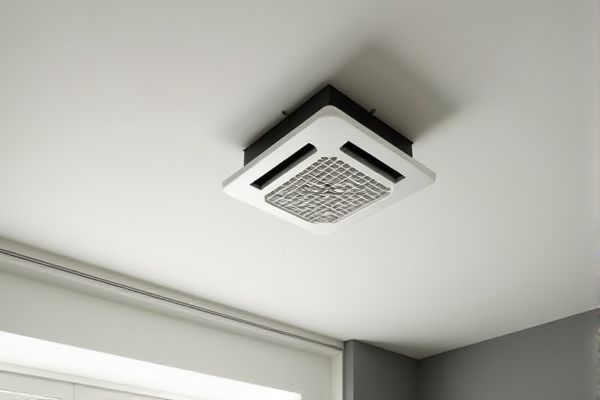
Ceiling vent fans are installed directly in the ceiling and provide immediate air extraction from the room, making them ideal for smaller spaces, while in-line vent fans are placed within the ductwork, offering quieter operation and greater flexibility for larger or multiple rooms. Explore the rest of the article to determine which vent fan best suits your ventilation needs and enhances your home's air quality.
Table of Comparison
| Feature | Ceiling Vent Fan | In-Line Vent Fan |
|---|---|---|
| Installation Location | Mounted directly on the ceiling | Installed within the ventilation ductwork |
| Noise Level | Moderate, audible in the room | Low, noise isolated in ductwork |
| Airflow Capacity | Typically 50-110 CFM | Higher, ranges 100-400+ CFM |
| Space Saving | Consumes ceiling space | Hidden inside duct, saves room space |
| Maintenance | Easy access for cleaning and repairs | Requires ductwork access for servicing |
| Application | Ideal for small rooms, bathrooms | Suitable for larger areas, multi-room ventilation |
| Cost | Lower initial and installation cost | Higher cost due to complexity and capacity |
Introduction to Ventilation Fans
Ceiling vent fans are installed directly in the ceiling and are effective for localized ventilation, particularly in bathrooms and small rooms, where they remove moisture and odors efficiently. In-line vent fans are positioned within the ductwork, allowing for quieter operation and longer duct runs, making them ideal for larger spaces or multiple rooms requiring centralized ventilation. Both types enhance indoor air quality but differ in installation complexity, noise levels, and airflow capacity.
Overview: Ceiling Vent Fan vs In-Line Vent Fan
Ceiling vent fans are installed directly in the ceiling and provide localized ventilation by exhausting air from a specific room, making them ideal for bathrooms and small spaces. In-line vent fans are mounted within the ductwork and offer quieter operation along with the ability to serve multiple rooms or longer duct runs. Your choice depends on space constraints, noise preference, and ventilation coverage requirements.
Design and Installation Differences
Ceiling vent fans are installed directly into the ceiling, providing a compact and discreet solution ideal for small to medium-sized spaces, while in-line vent fans are mounted within the ductwork, allowing for quieter operation and flexible placement in larger or multi-room ventilation systems. Ceiling fans often require cutting a hole in the ceiling and may include decorative grilles, whereas in-line fans demand access to duct runs and additional support structures for secure installation. The design differences influence airflow efficiency, noise levels, and maintenance access, making in-line fans more customizable and suitable for complex ventilation needs.
Airflow Efficiency and Coverage
Ceiling vent fans typically provide direct airflow, effectively ventilating individual rooms with higher immediate air exchange rates, making them suitable for localized moisture and odor control. In-line vent fans are installed within the ductwork, offering greater airflow efficiency by reducing noise and increasing coverage across multiple rooms or longer duct runs. Their design minimizes pressure loss, resulting in more consistent ventilation performance throughout larger or complex spaces.
Noise Levels and Operation
Ceiling vent fans typically produce more noise due to their direct installation within the living space, causing vibrations and sound to resonate in the room. In-line vent fans are installed within the duct system, significantly reducing noise levels by isolating the fan motor away from the room, offering quieter operation. For your home, choosing an in-line vent fan can ensure a more peaceful environment without sacrificing ventilation efficiency.
Energy Efficiency Comparison
Ceiling vent fans generally consume less power due to their direct installation in the room, allowing efficient air extraction with minimal ductwork resistance. In-line vent fans, positioned within ducts away from the room, often provide higher airflow capacity but may require more energy to overcome longer duct runs and added friction. Your choice between these systems should balance energy efficiency needs with ventilation effectiveness for the specific space configuration.
Maintenance Requirements
Ceiling vent fans require regular cleaning of the grill and motor to prevent dust buildup and ensure optimal airflow, while in-line vent fans need periodic inspection and cleaning of ductwork to avoid blockages and maintain efficiency. Your maintenance efforts will typically be simpler for ceiling vent fans due to easier access compared to in-line fans installed within ceiling cavities or walls. Choosing the right fan depends on your willingness to perform these upkeep tasks to extend the lifespan and performance of your ventilation system.
Cost Analysis: Initial & Long-Term
Ceiling vent fans generally have a lower initial cost, ranging from $50 to $150 including basic installation, making them budget-friendly for immediate needs. In-line vent fans, while costing between $200 and $500 upfront due to more complex installation and components, often provide better long-term energy efficiency and quieter operation, reducing electricity expenses and maintenance costs over time. When assessing your ventilation solution, consider your budget for both installation and ongoing energy use to determine which fan offers the best value for your home.
Best Applications for Each Type
Ceiling vent fans are best suited for small to medium-sized rooms like bathrooms and kitchens, providing direct ventilation and moisture control by exhausting air immediately outside. In-line vent fans excel in larger spaces or when the vent location is remote, as they install within the ductwork to efficiently move air over longer distances with reduced noise. Your choice depends on the specific ventilation needs and room layout, ensuring optimal air circulation and humidity management.
Conclusion: Choosing the Right Vent Fan
Ceiling vent fans are ideal for small to medium-sized rooms, offering direct and efficient ventilation with simple installation. In-line vent fans excel in larger spaces or complex duct systems by providing quieter operation and greater airflow flexibility. Selecting the right vent fan depends on room size, noise preferences, and ductwork configuration to ensure optimal air circulation and moisture control.
 homyna.com
homyna.com